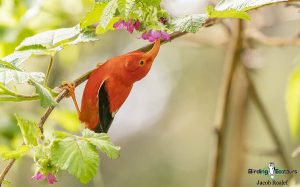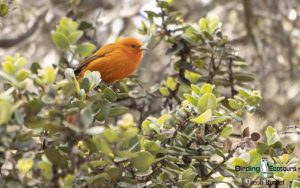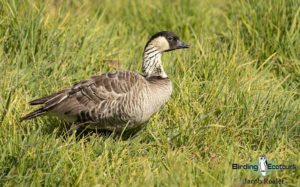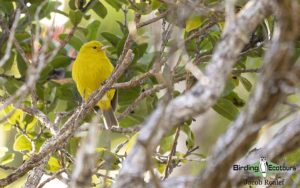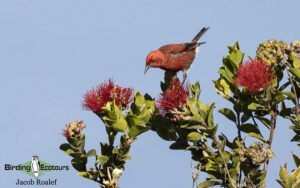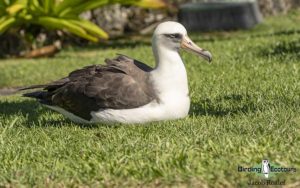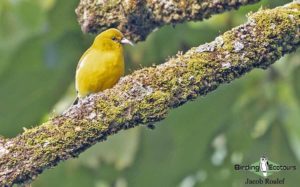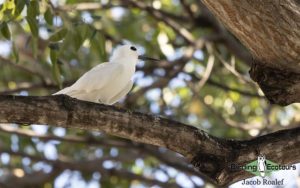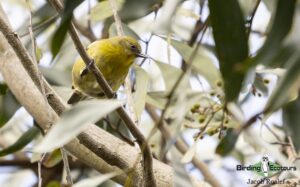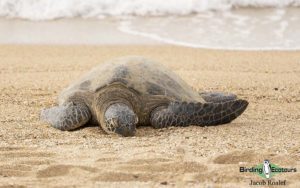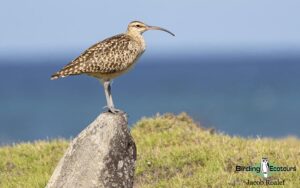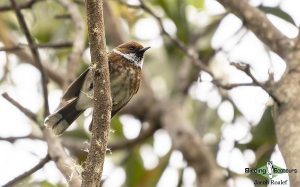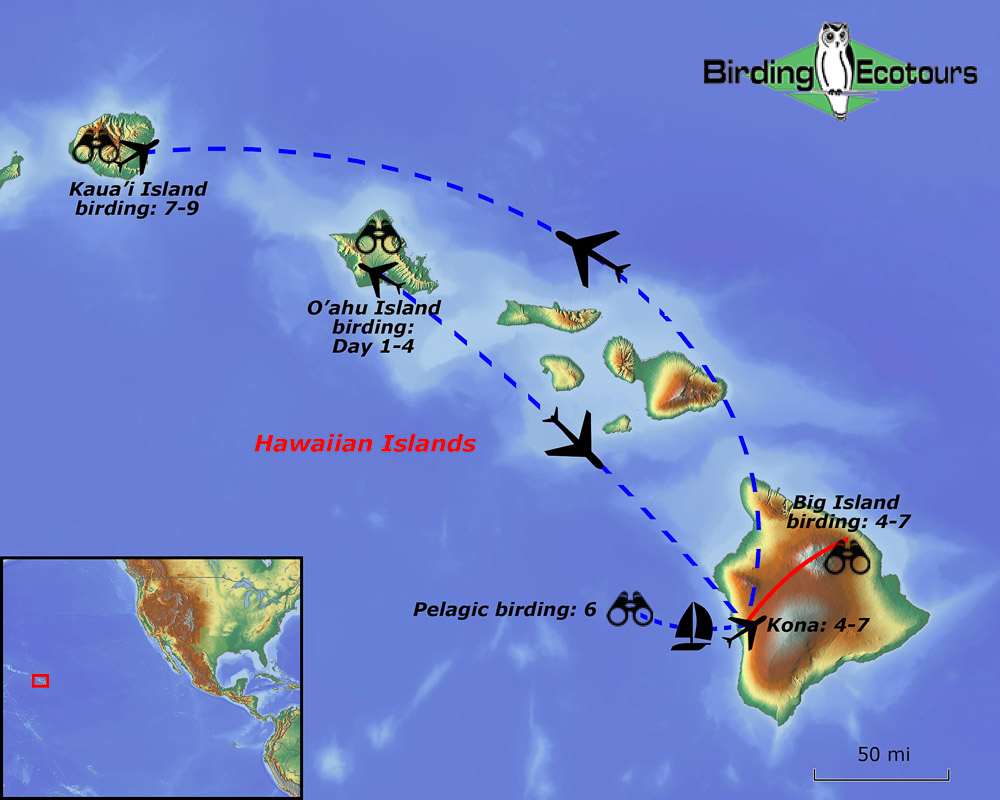Birding Tour USA: Hawaii – ABA & Endemic Birding in the Pacific
Birding Tour USA: Hawaii – ABA & Endemic Birding in the Pacific
February 2026/2027
Hawaii – commonly referred to as the ‘Aloha State’ with its welcoming atmosphere, is a tropical paradise that is about as unique as they come. Once an independent nation, years ago, Hawaii is now an officially recognized US state, making up one of the 50 American states. Hawaii is comprised of a string of islands known as the Hawaiian Archipelago, located far out in the Pacific Ocean, isolated from the rest of the world. There are eight primary islands that feature in the archipelago, namely – Niʻihau, Kauaʻi, Oʻahu, Molokaʻi, Lānaʻi, Kahoʻolawe, Maui, and Hawaiʻi (Big Island).
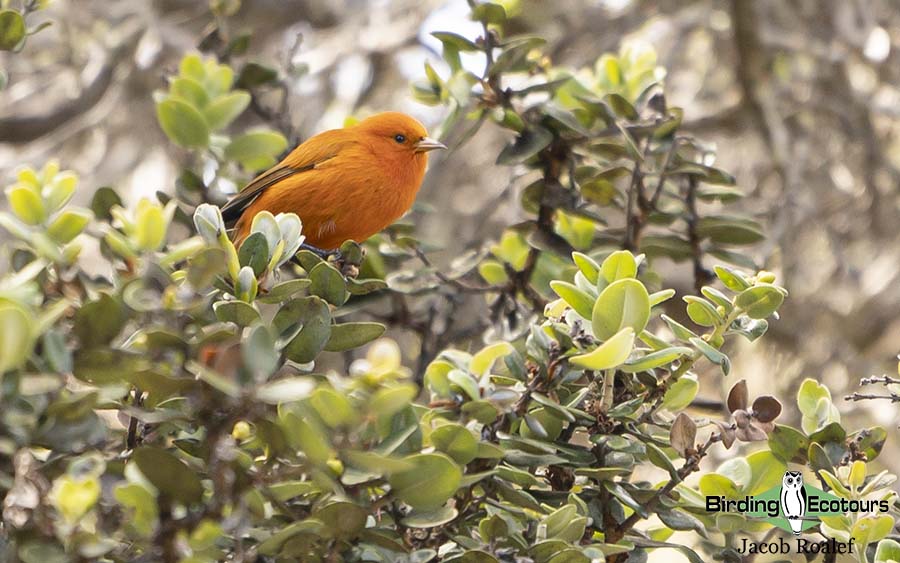
Hawaii is well known as a prime vacation and wedding destination and has a great many highlights featuring some of the best surfing in the world and the largest naval command in the world. Hawaii’s biodiversity and in particular its avifauna is somewhat less well-known, and historically hasn’t accounted for much of the tourism boom to the region – but this is steadily changing. It is one of those birding destinations to visit as soon as possible before more endemics go extinct.
Due to its isolation from the rest of the world, Hawaii has a very high rate of endemism and features a number of strange and peculiar-looking birds, found nowhere else. It is extremely unfortunate that indeed a great number of various Asian and European species were introduced to these islands, as these, together with other introduced taxa, and the spread of mosquitos and avian malaria, have all had a devastating impact on the local biodiversity, and especially its birdlife. A large number of species have become extinct, with many more species now rare and thinly distributed, and on the precipice of extinction.
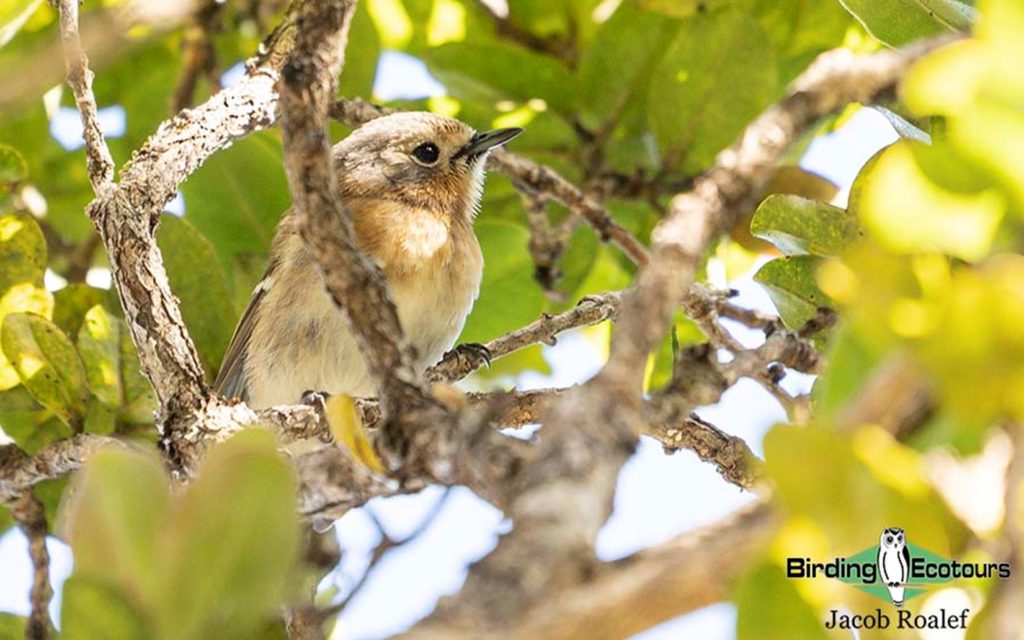
The official recognition of Hawaii and its birds as countable for the official ABA checklist, has encouraged a great many American-based birders to venture to these islands in search of the unique species found here. Although the region has drawn in ‘world-birders’ seeking to add these endemic species to their world lists, this inclusion has had a widespread positive impact on raising awareness of the plight of Hawaii’s threatened birds. It is thus with a great deal of pride that we added our birding tour to Hawaii in 2021, as we strive to continue help raising awareness of the plight of Hawaii’s endemic birds, and indeed help various conservation bodies throughout the state of Hawaii.
Our birding tour takes in the three main and easily accessible islands, O’ahu, Kauaʻi and Hawaiʻi (the latter more commonly known as Big Island). Here we focus our efforts on getting to the different sections of higher-altitudinal montane forest, in search of the various endemics and specials that still persist, while also ensuring we try and find as many of the introduced species as possible. Some of the islands’ most sought-after endemics include such species as Iiwi, Akiapolaau, Apapane, Akekee and Anianiau, through to more widely known species such as Nene (Hawaiian Goose) – which is also the official state bird of Hawaii. Unfortunately, since 2021 Palila has become difficult to find; this Hawaii tour is definitely one to do as soon as possible before more species slip into extinction. We’ve now slightly abbreviated our tour (by a day) as we will only make an attempt for Palila if we feel it worthwhile. We have unfortunately come to terms with the fact that Palila should no longer be a target species and spending an entire day looking for a bird that is most likely gone, is not worth our previous efforts.
Other desirable species such as Bristle-thighed Curlew, Hawaiian Petrel, White Tern, and Laysan Albatross also form core targets on our tour.
Hawaii’s blend of highly localized birds, jaw-dropping coastal vistas and the feeling of being in a tropical island paradise – all the while adding species to both your world and ABA lists, make Hawaii a destination not to be missed!
Itinerary (9 days/8 nights)
Day 1. Arrival in Honolulu, O’ahu
Today is your arrival day, and you can arrive at your leisure. Upon arrival in Honolulu (HNL) you will be transferred to our comfortable lodge, where we will spend the next three nights. Should there be time available in the afternoon, we may do some local birding nearby, getting familiar with some of the more regularly occurring species (see under Day 2 below for more details). We will gather in the lobby at 6 pm for our welcome dinner.
Overnight: Queen Kapiʻolani Hotel, Waikiki
Day 2. Birding O’ahu – Waikiki to the Koʻolau Range
Our first morning will be spent birding around the Kapiʻolani Regional Park. One of the star species here is White Tern, while Pacific Golden Plover is another sought-after bird at this site. A wide array of introduced species can also be sought and include the likes of Rose-ringed Parakeet, Zebra and Spotted Doves, Java Sparrow, Common Waxbill, Red-crested Cardinal and Yellow-fronted Canary. The rest of the day is spent outside of Wakiki in the forests of the Koʻolau Range where we will primarily search for the endemic Oahu Amakihi and the Oahu Elepaio. Both of these species are red-listed as per the IUCN Red List (being Vulnerable and Endangered, respectively). Indeed, rather tragically, many of the other endemic species occurring throughout the Hawaiian Islands are also red-listed and many of them Critically Endangered. Further introduced species, such as White-rumped Shama, Warbling White-eye and Red-billed Leiothrix can be seen in this area as well.
Overnight: Queen Kapiʻolani Hotel, Waikiki
Day 3. Birding O’ahu – The north shore
Our day will be spent birding and exploring the coastal region along the north shore of the island. Although perhaps more well-known for its picturesque beaches, with world-class surfing, the secluded coves and tracts of shoreline, along with the vast family farms (with crops of coffee, cacao and many others) are home to the highly sought-after Bristle-thighed Curlew, along with a wide range of other targets such as Wandering Tattler, an endemic subspecies of Black-necked Stilt and the endemic Hawaiian Coot. Further introduced species such as Saffron Finch and Chestnut Munia can also be found in the area.
Overnight: Queen Kapiʻolani Hotel, Waikiki
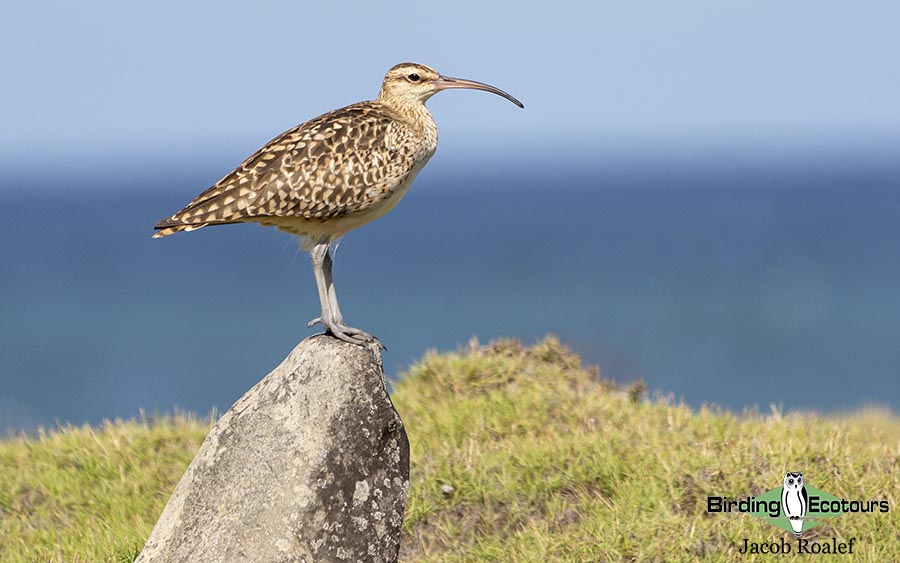
Day 4. Birding Big Island – Pu’u La’au, Mauna Kea and surrounds
We’ll fly to Big Island after breakfast. Here, we will start our birding, ranging from the high elevations of Pu’u La’au on the slopes of the dormant volcano, Mauna Kea, along the Saddle Road, to the more coastal Waikōloa area. We will look for Hawaii Elepaio, but the Critically Endangered (IUCN) Palila is not reliably found any more. Other birds we hope to encounter include Short-eared Owl, Wild Turkey, California Quail, Erckel’s Spurfowl, Black and Grey Francolins, Chukar Partridge, Chestnut-bellied Sandgrouse, Eurasian Skylark and African Silverbill.
Overnight: Royal Kona Resort, Kona
Day 5. Birding Big Island – Hakalau Forest National Wildlife Refuge
One of the most important birding sites for endemic Hawaiian species, throughout all of the Hawaiian Islands, is the Hakalau Forest National Wildlife Refuge. Dominated by montane cloud forest, with a strong suite of native plants and general wildlife still largely persisting, we will spend the entire day birding this wonderful protected and highly restricted area. Some of our target species here include the likes of Hawaiian Hawk, Omao, Hawaii Creeper, Hawaii Akepa, Akiapolaau, Iiwi, Hawaii Amakihi and Apapane. Whilst exploring the area for these species, and others, the ancient ohia trees that dominate the area will take you to a time period long past, allowing us to better understand the plight of Hawaii’s endemic species.
Overnight: Royal Kona Resort, Kona
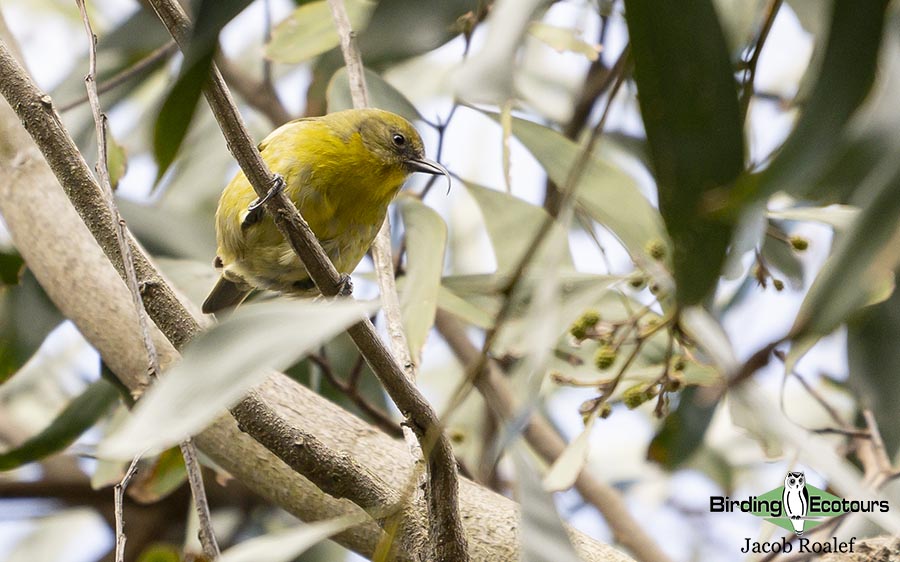
Day 6. Pelagic Birding off Big Island
Today we will undertake a pelagic trip out of Honokohau Harbor. Together with our trusty captain and boat, we will spend most of the day out in the deep. In between the more regularly occurring species, we’ll keep a keen eye open for the likes of a wide range of exciting and fast-flying gadfly Pterodroma petrels, namely Hawaiian, Juan Fernandez, Mottled, White-necked and Black-winged Petrels, Christmas and the Critically Endangered (IUCN) Newell’s Shearwaters, Leach’s and Band-rumped Storm Petrels, Masked Booby, South Polar Skua and more. Indeed, the truly exciting aspect about pelagic birding is that you can never truly predict what you’ll see out there! More regularly occurring species typically seen include Wedge-tailed and Sooty Shearwaters, Bulwer’s Petrel, Great Frigatebird, the stunning White-tailed Tropicbird, Brown Booby, Sooty Tern and both Black and Brown Noddies. Occasional cetacean sightings can also feature on these trips.
Following an excellent day out on the water, we will enjoy our dinner together, and reminisce about the many exciting birds we would have seen.
Overnight: Royal Kona Resort, Kona
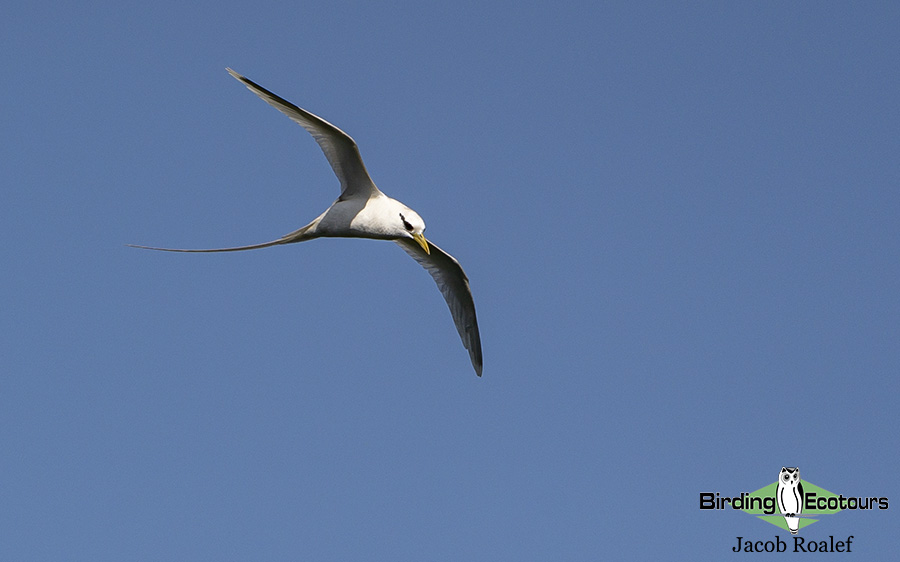
Day 7. Flight to Kaua’i and birding Kaua’i
After breakfast we will head to the airport for our flight (usually mid-morning) to Lihue on Kaua’i. Following our arrival, we will begin exploring Kaua’i’s beautiful north shore. We will focus our efforts around the rugged cliffs of the coastal Kīlauea Point National Wildlife Refuge and the freshwater-dominated Hanalei National Wildlife Refuge. One of our main targets at Kīlauea Point is the stunning Laysan Albatross – small numbers of which breed here. Other species we’ll search for are Red-footed and Brown Boobies, stunning Red-tailed and White-tailed Tropicbirds and Great Frigatebird (a similar, yet different species from the Magnificent Frigatebird occurring on mainland USA). Nene (also known as Hawaiian Goose), which is the state bird of Hawaii, usually provide us with great views throughout the day as well. Hawaiian Duck will be one of our main targets at the Hanalei National Wildlife Refuge.
Overnight: Sheraton Kauai Coconut Beach Resort, Kapaa
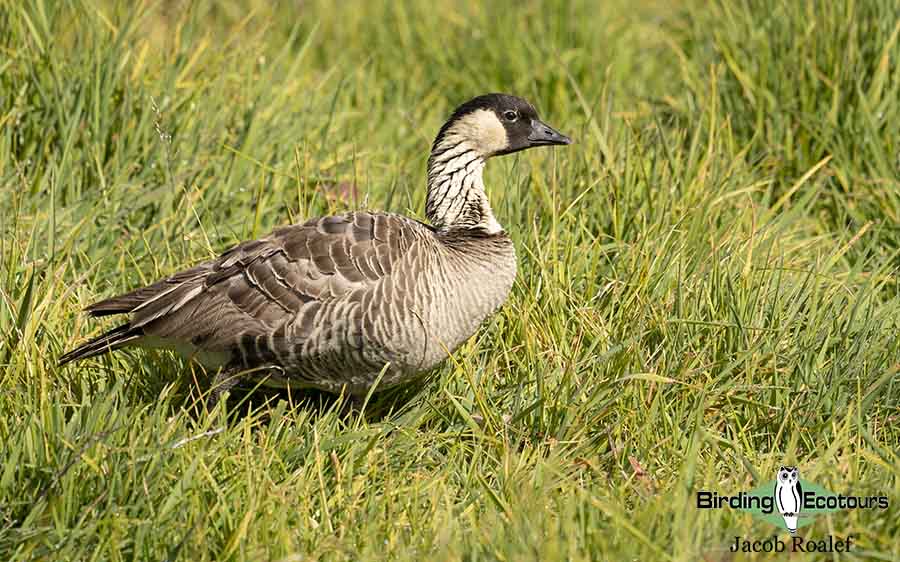
Day 8. Birding Kaua’i – Kōkeʻe State Park
We will dedicate the day to birding and exploring the glorious Kōkeʻe State Park. This lush mountainous park offers the best endemic birding on the island, and we will spend our time birding the rainforests for a wide assortment of difficult-to-pronounce specials such as Kauai Amakihi, Apapane, Anianiau, Kauai Elepaio and even the rare and IUCN Critically Endangered Akekee. This area also plays host to further introduced (yet countable) species such as Red Junglefowl, the difficult-to-see Japanese Bush Warbler, and Chinese Hwamei. Aside from this exciting endemic birding, we are also assured to enjoy incredible vistas of the Waimea Canyon, known as the ‘Grand Canyon of the Pacific’.
Overnight: Sheraton Kauai Coconut Beach Resort, Kapaa
Day 9. Departure from Lihue, Kaua’i
Depending on homeward flight times, we may have some time available this morning to continue birding and exploring Kaua’i. If we haven’t yet seen Greater Necklaced Laughingthrush, this will be a good species to target today, although we will need some luck to see it. We can also try and clean up on any other species we are still missing.
The tour comes to an end today, and you can depart home from Lihue.
Please note that the itinerary cannot be guaranteed as it is only a rough guide and can be changed (usually slightly) due to factors such as availability of accommodation, updated information on the state of accommodation, roads, or birding sites, the discretion of the guides and other factors. In addition, we sometimes have to use a different guide from the one advertised due to tour scheduling and other factors.
Download ItineraryHawaii: Set Departure Trip Report
30 JANUARY – 08 FEBRUARY 2023
By Jacob Roalef
DOWNLOAD TRIP REPORT
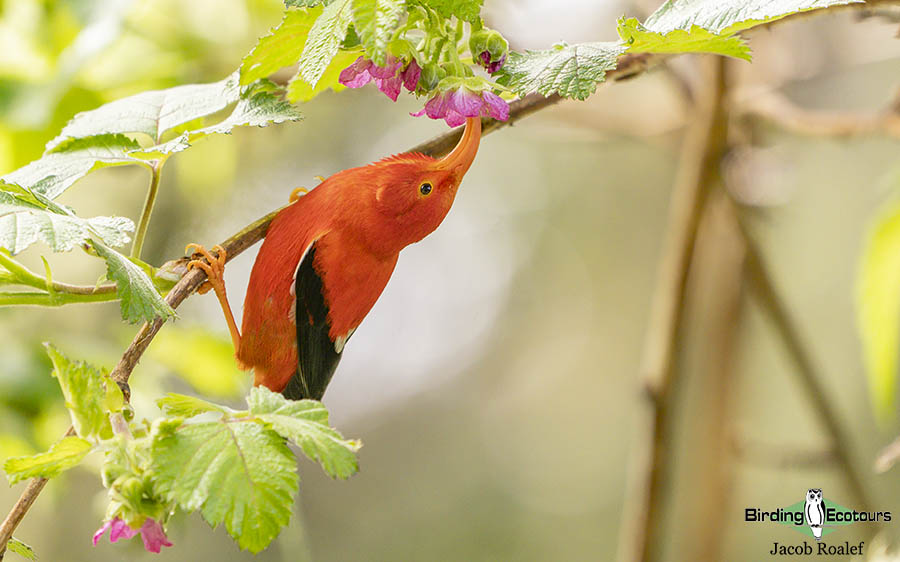
Overview
This ten-day set departure tour of Hawaii began in Honolulu with exploration of the island of O‘ahu and then proceeded to two more of the Hawaiian Islands: Kaua‘i and Hawai‘i (also known as the big island). We visited several fantastic birding locations, including the Ko‘olau Range, the North Shore, Hanalei National Wildlife Refuge, Koke‘e State Park, Pu‘u La‘au, Mauna Kea, an open ocean pelagic and the paradise of Hakalau Forest National Wildlife Refuge.
We recorded many amazing bird sightings, including a variety of endemics, seabirds, and introduced species, giving us an impressive list for the Hawaiian Islands in the short space of ten days. Avian highlights included White Tern, Red-tailed and White-tailed Tropicbirds, Red-footed and Masked Boobies, Red Avadavat, Laysan Albatross, Black Francolin, Chestnut-bellied Sandgrouse, Bristle-thighed Curlew, I‘iwi, ‘Akiapola‘au, ‘Anianiau, ‘Apapane, and an ABA area rarity in the form of Grey-tailed Tattler. We were also successful with the island sweeps of the ‘Amakihi and ‘Elepaio species, plus many others.
A total of 91 bird species were seen, along with a couple of fantastic mammal sightings including a mega pod of Melon-headed Whales, a few lounging Hawaiian Monk Seals, and newborn baby Humpback Whale! Other wildlife highlights were Hawaiian Green Sea Turtle, Flying Fish, and an optional night excursion to see Manta Rays up close and personal in the water. Full bird and mammal checklists can be found at the end of this report.
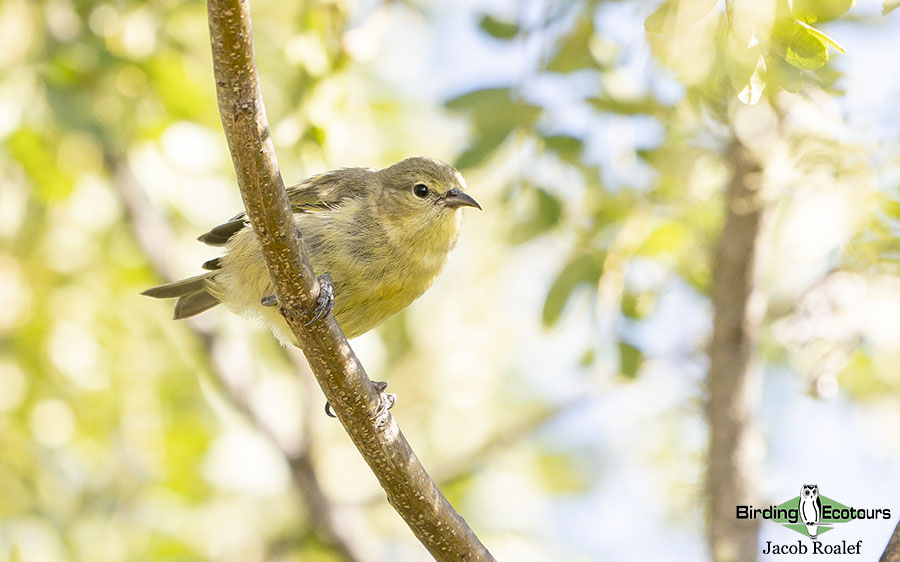
Detailed Report
Day 1, 30th January 2023. Arrival and welcome dinner.
All participants arrived in Honolulu and were transferred to the hotel for check-in and a bit of rest after the long journey to the middle of the Pacific. We met at 6pm in the lobby for group introductions and our first dinner together at the lovely hotel restaurant where we managed to note a few of the common species like Spotted Dove, Red-vented Bulbul, and Common Myna. It was then time for sleep in preparation for our first full day of birding.
Day 2, 31st January 2023. Birding O‘ahu – Waikiki to the Ko‘olau Range
After a tasty breakfast at the hotel, we loaded up in the van to begin our Hawaiian birding adventure. We wove our way through the traffic and ascended in altitude towards the Tantalus Ridge. We noted several of the more common species as we drove, like Zebra Dove and Cattle Egret. The view of the city below was spectacular, with a lovely rainbow included, which was only fitting for the rainbow state. It didn’t take long after getting out of the van for us to hear our top target up here . The conditions were a bit challenging, with a constant drizzle of rain, but it did not deter our group and we soon had excellent views of the endemic O‘ahu ‘Amakihi. We descended the mountain and arrived on a busy street in Honolulu where, for some reason, a group of White Terns had decided it was the perfect location for nesting! These were absolutely stunning birds, and such a strange setting to see them, with loud traffic all around. From here we headed off to Kapiolani Park, very close to the famous Waikiki Beach. The trees and grasses here were loaded with notorious species introduced to Hawai‘i, like Common Waxbill, Java Sparrow, Yellow-fronted Canary, Rose-ringed Parakeet, Red-crested Cardinal, and Saffron Finch.
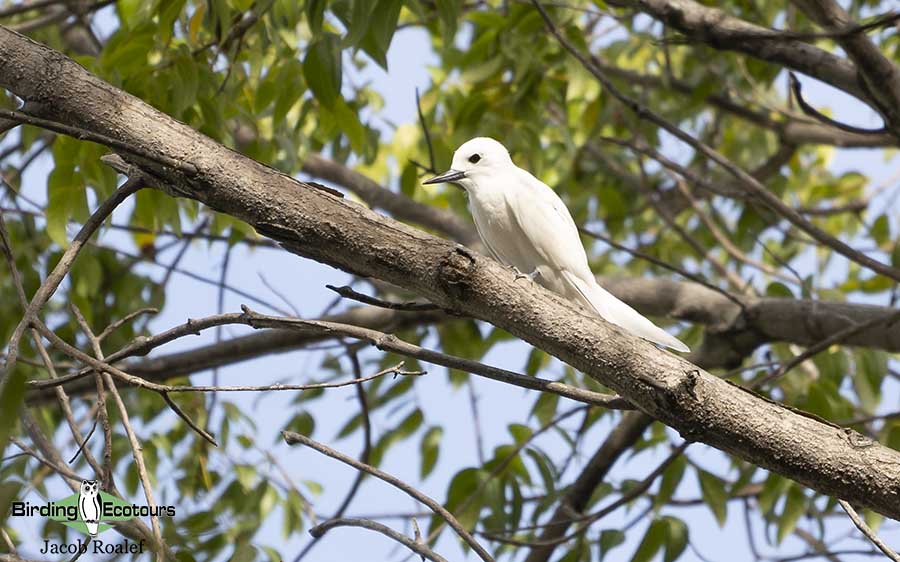
It was now time for lunch, so we made an order to go and enjoyed some local poke bowls at the Lana‘i Lookout, where we were treated to an incredible show of Red-tailed Tropicbirds flying by and displaying close. We even managed to spot one on a nest in the nearby cliffs. Next up was our other top target for this island – another fantastic endemic. We headed off for a short hike into the nearby valley, equipped with waterbottles and insect repellent. Along the route to our destination, we saw a few more exotic species like Red-whiskered Bulbul, Red-billed Leiothrix, and White-rumped Shama. After a fair bit of searching, we managed to spot the star bird, the endangered O‘ahu ‘Elepaio! We were very lucky to watch a pair of these amazing birds as they constructed their nest. This was the perfect sight to cap off our fantastic day of birding on O‘ahu.
Day 3, 1st February 2023. Birding O‘ahu – The North Shore
With both of our top target species for O‘ahu in the bag we were off to a great start, and ready to tackle a few more target species today. After breakfast we headed to Sandy’s Beach and Makapu‘u Lookout, where we picked up our first Red-footed and Brown Boobies of the trip. Our next stop was the Ka‘elepulu Wetlands, with fantastic views of the endemic Hawaiian Coot, along with the Hawaiian subspecies of both Common Gallinule and Black-necked Stilt. From here we continued our journey around the island and arrived at the Marine Corps Base, which hosted a nice wetlands area allowing us to scope out a locally rare Caspian Tern. We also enjoyed a few close Scaly-breasted Munias, our first for the trip.
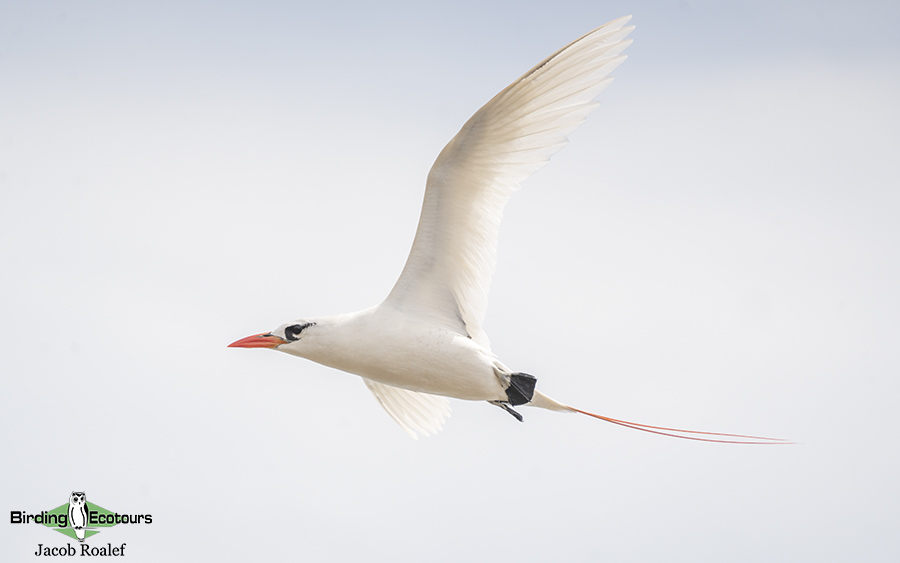
After lunch it was time for a short hike along the Kahuku Golf Course. The course was littered with Pacific Golden-Plovers and Zebra Doves. We eventually reached our destination and were immediately treated to a pair of Bristle-thighed Curlews, a highly-desired species and top target here. We spent some time here and enjoyed these amazing birds before hiking back to the van, where we saw our first Northern Cardinal. Our final planned stop of the day was a brief look at the nearby Kahuku Aqua Ponds, which netted us Sanderling and Ruddy Turnstone, both firsts for the trip. During our drive back to Honolulu, Mandy spotted a small group of Red Avadavats while we were stuck in traffic! A fantastic sighting, as these little birds can be incredibly difficult to find and are highly localized. Everyone managed views and then we settled back into the traffic and continued along to the hotel and dinner.
Day 4, 2nd February 2023. Birding Kaua‘i – Hanalei NWR
Today the morning consisted of a more leisurely breakfast, packing, and a trip to the airport to catch our flight to the next island, Kaua‘i. We landed around noon and began our adventure on island number two. First on the agenda was lunch, which we enjoyed outside and spotted Hawaiian Goose, Great Frigatebird, and Western Meadowlark while we ate. With our bellies full, we headed off to the Princeville Golf Course and experienced the wonders of parenthood up close and personal. We met a local Laysan Albatross father named Larry and watched as he cared for his recently hatched chick. Truly a special moment with an incredible bird. We continued our search of the area and spotted a Snow Goose mixed in with the Hawaiian Geese, and there was a small flock of Chestnut Munias nearby as well.
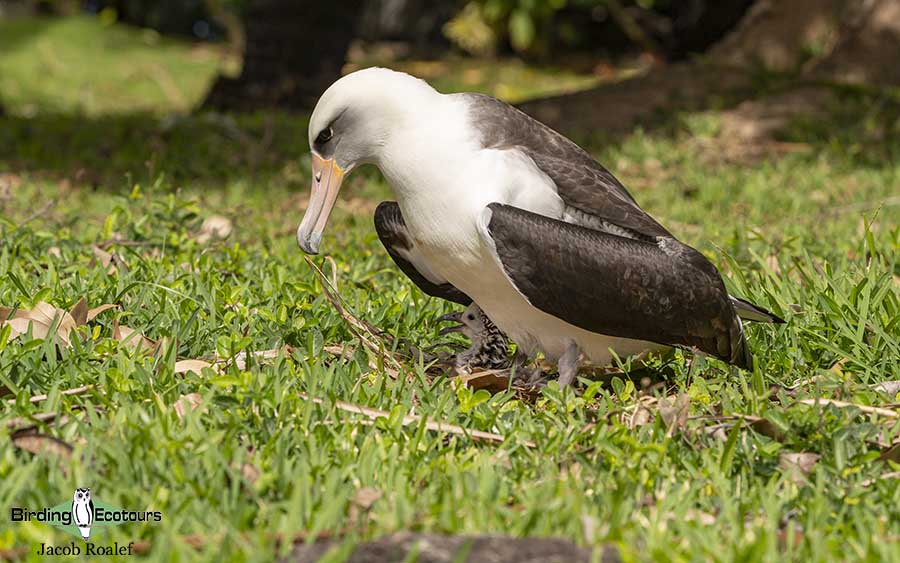
After our lovely time on the golf course, we headed off to Hanalei National Wildlife Refuge to search for our next target. It didn’t take long for us to spot the endangered Hawaiian Duck. As we scoped a few birds from the road, Mandy turned around and all of a sudden saw a tiny duckling at our feet! Surely it was a Hawaiian Duck with no mother around, so it was up to us to save this poor little bird and do our part to help protect this species. We had quite an adventure with our little duckling as we tracked down some refuge employees who would be able to properly care for it and get it the help it needed. It is not everyday that one gets the opportunity to be a part of a rescue team for an endangered species! The day was now winding down, so we finished up with an early evening watch at the Kilauea Lighthouse. Here we enjoyed hundreds of Red-footed Boobies as well as some soaring Laysan Albatrosses and Great Frigatebirds. A few Humpback Whales were also seen way offshore. A great finish to our first day on Kaua‘i.
Day 5, 3rd February 2023. Birding Kaua‘i – Koke‘e State Park
The weather forecast for the morning made it clear that we would be in for a battle against the constant misting rain, as is typical in the wet forests of these islands. Nonetheless, our group was ready for this and not deterred. We headed into Koke‘e State Park, with a quick stop at Waimea Canyon first, to take in the views of what is deemed “The Grand Canyon of the Pacific”. While we were there, the clouds and fog rolled in, and the rain began. We noted a few birds, including Red Junglefowl and Warbling White-eye. We made it up to higher elevations in Koke‘e and managed to find our first endemic species, ‘Apapane. The birding was slow in these conditions, but we still managed to get views of two more endemic species, ‘Anianiau and Kaua‘i ‘Elepaio. We headed back down to the state park lodge to dry off a little and get some warm food and drinks.
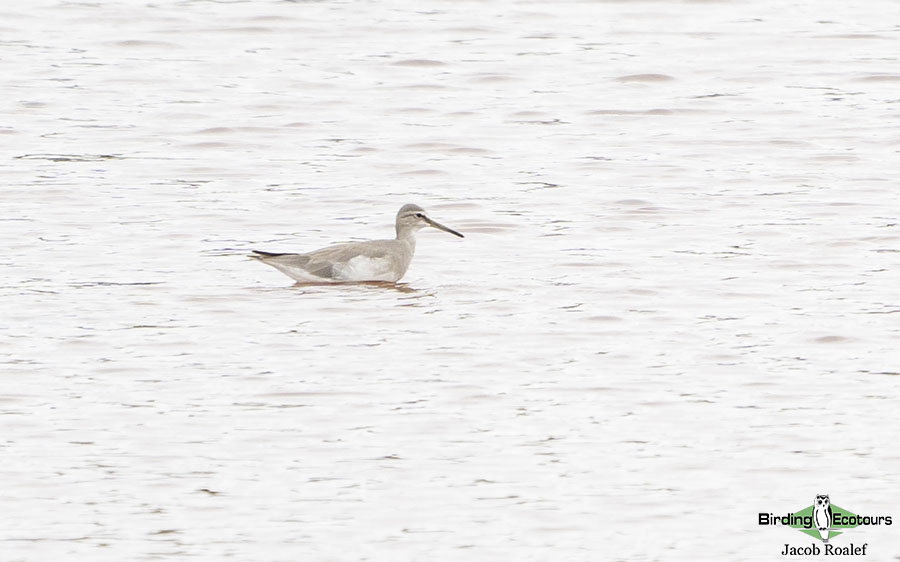
After lunch we decided to venture back to the top of the mountain here, as we were still missing one of the key endemics. While the rain was still misting, we managed to hear and then spot the Kaua‘i ‘Amakihi quickly! This is certainly the toughest of the four target endemic species here, so it was great to get some views of a male. After this we began our journey out of the wet forests and back down to the coastline. Along the way we spotted our first Northern Mockingbird and African Silverbill of the trip, and then reached the Salt Ponds. It wasn’t long before we were onto an interesting bird in the water here. As we got closer, it became clear that we had spotted a rare vagrant Grey-tailed Tattler! An excellent find to go along with the Wandering Tattler, Ruddy Turnstone, Sanderling, and Black-necked Stilts here. We made it back to the hotel where we enjoyed a well-deserved and delicious meal after a very successful day.
Day 6, 4th February 2023. Flight to Hawai‘i, the big island
We all met up this morning for a tasty breakfast at the hotel as usual, but while we ate, we saw something rarer than any bird- a thunderstorm on Kaua‘i! While it often rains on the tropical islands of Hawaii, actual storms with high winds and lightning are incredibly rare . In fact, a few of the locals we spoke to said this was only the third storm here that they’d seen in their entire lives. Of course, this was amazing to see, but unfortunately meant that our morning birding plans had to be cancelled because it was too dangerous in these conditions. Instead, everyone got a nice break mid-trip to catch up on rest, work on photo editing, and enjoy the rooms of this wonderful hotel.
The storm eventually stopped around 11am, right when we needed to check out. We met up in the lobby, left our luggage there with the helpful staff and ventured out for a bit of birding. We decided to grab some lunch and take it to the nearby Poipu Beach Park and enjoy it by the water. In addition to a tasty lunch we enjoyed a few great wildlife sightings, including Hawaiian Green Sea Turtles and a pair of Hawaiian Monk Seals lounging on the beach. We still had a short time left, so we headed over to Opaeka‘a Falls to enjoy the scenic view. Here we spotted a pair of White-tailed Tropicbirds circling the cliffs, and a Red Junglefowl hen jumped into the van and wanted to go with us! From here we headed back to the hotel to gather our luggage and go to the airport to catch our flight to the third and final island of the trip, Hawai‘i (the big island).
Day 7, 5th February 2023. Birding Hawai‘i – Mauna Kea and Waikoloa
Our first morning on the big island started with breakfast and then a trip to the Kealakehe Wastewater Treatment Plant, because no trip is complete without a visit to a water treatment facility. The place was teeming with birds and we added many new species for the trip, including Cackling Goose, Lesser Scaup, Ring-necked Duck, Black Francolin, Ruff, White-faced Ibis, and Yellow-billed Cardinal. After a thorough search of the treatment plant, we made the long journey to Pu‘u La‘au and the dry forests of Mauna Kea. We explored the trails here for a couple of hours and picked up our first two endemics of the island, Hawai‘i ‘Amakihi and Hawai‘i ‘Elepaio. We also caught a few fleeting glimpses of the difficult to see Japanese Bush Warbler. Atunchtime we headed to the town of Waikoloa. Along the way we spotted an Erckel’s Spurfowl up on a fence post, and noted a few Eurasian Skylarks displaying in the distance.
In town we decided to enjoy lunch outside, in the beautiful sunny weather, and we were treated to a small group of Rosy-faced Lovebirds busily flying around and working on nests. After we finished eating, we headed off to the local skatepark, where we searched for a few new species. We managed some fantastic views of Grey Francolin and African Silverbill. We didn’t find our top target, so we drove around the neighborhoods and, not far from the park, we stumbled across the gorgeous Chestnut-bellied Sandgrouse. There were eight birds in total and they were right next to the road, offering us some jaw dropping views. To close out the day we drove up to higher elevations along Kaloko Drive, where we spotted a few Kalij Pheasants, before it began to drizzle and fog rolled in. It was time to head back to the hotel, have dinner, and do our checklists, adding many new trip birds today.
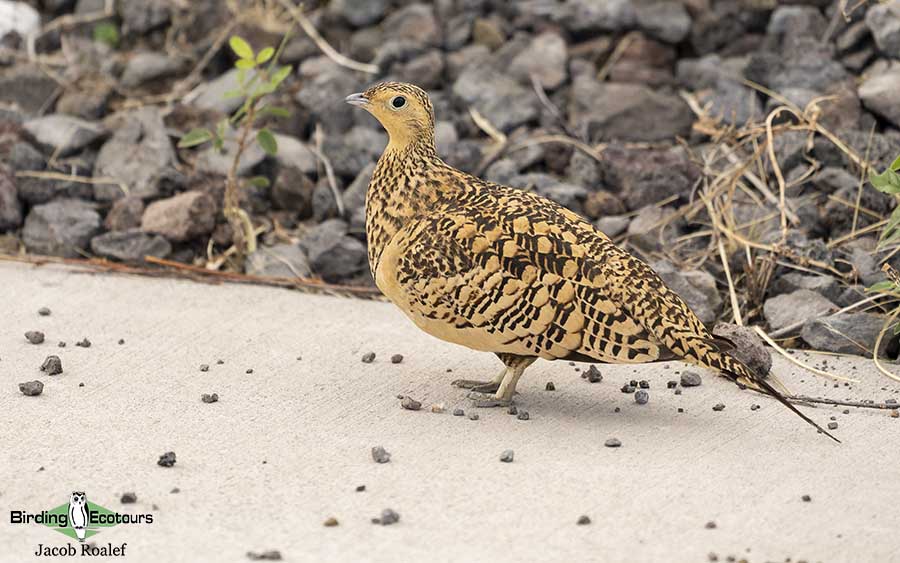
Day 8, 6th February 2023. Birding Hawai‘i – Hakalau Forest NWR
Today was probably the most anticipated day of the entire trip. One could feel everyone’s excitement at breakfast, as we would get to visit the pristine and amazing Hakalau Forest National Wildlife Refuge, one of the only remaining tracts with native trees and vegetation. Before entering the restricted forest we briefly ventured to higher altitudes and found a small group of Chukars along the side of the road. We then entered Hakalau and were greeted by a few Hawaiian Geese in the parking area. The morning started off with some light rain, as is expected in this wet forest, but thankfully the rainstopped after about 45 minutes and it turned into a stunner of a day, which is rare for this forest. The native birds reacted in turn to the sunshine, and we were soon surrounded by endemic species, with the most numerous being the clown-like I‘iwi and Hawai‘i ‘Amakihi. By the time we sat down for a picnic lunch, we already had views of ‘Akiapola‘au, ‘Oma‘o, Hawai‘i ‘Elepaio, and Hawaiian Creeper. We were serenaded by I‘iwi and ‘Apapane as we enjoyed our lunch, certainly an unforgettable experience. After lunch, we managed to find the final endemic we needed, the Hawai‘i ‘Akepa, as well as some better views of the incredibly unique ‘Akiapola‘au. Our time inside of Hakalau was certainly one for the record books, and it was easy to see why this is the top highlight location of the trip.
On our way out of the forest and back to the main road we drove down the dirt and gravel roads, which contained more open areas, where we spotted the ‘Io (Hawaiian Hawk) perched on top of a distant tree. Thankfully it stayed long enough for us to get scopes on it and enjoy this fantastic endemic species. It was now late in the afternoon, and we began the long journey back to the hotel. Along the way, we got on to a Short-eared Owl and watched as it hunted an open farm field. One could not ask for a better day of birding in Hawai‘i than the one we had today.
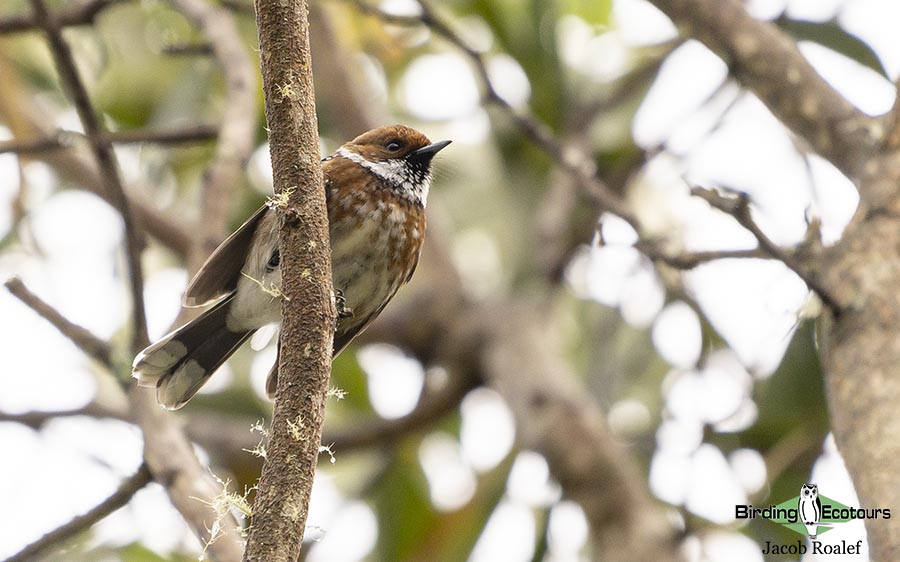
Day 9, 7th February 2023. Kona Pelagic Birding
We were up early today, loaded up the van and headed down to the boat docks, where we enjoyed some tasty breakfast in preparation for a full day out on the water. Pelagic birding in Hawaii is different from most places, since there are no gulls here to follow the boat and chumming does not work, so the best plan is to find as many bait balls of small fish as possible. We had our game plan and set off soon after dawn. It wasn’t long before we spotted our first of many Wedge-tailed Shearwaters, the default species for the day. The birding was slowand things quickly became a mammal show when we spotted the spout of a Sperm Whale and watched as it dove deep into the water. While this was a very rare sighting here, the top mammal highlight had to be a mother Humpback Whale with her calf of less than a week old. We got to watch as she constantly swam underneath to push the calf up to the surface to breathe, since it was not yet old enough to do this on its own. At the same time, these massive whales were surrounded by a mega pod of the smaller Melon-headed Whale. These smaller whales were certainly annoying the mother Humpback, but it was an unforgettable experience to be surrounded by marine mammals.
The birding aspect took second place on this day, but the action did pick up more in the afternoon when we found several bird piles. Mixed in amongst the groups of Wedge-tailed Shearwaters were Brown Noddy, Brown Booby, Sooty Tern, and Leach’s and Band-rumped Storm-Petrels. Towards the end of the day, we got onto the Hawaiian subspecies of the Black Noddy, which may be a future species split. The birding was certainly excellent, but the whales will forever be the outstanding memory for this day. We finally made it back to shore and we were all exhausted after a long day on the water in the sun, so we had a rest at the hotel to freshen up before our final dinner of the trip.
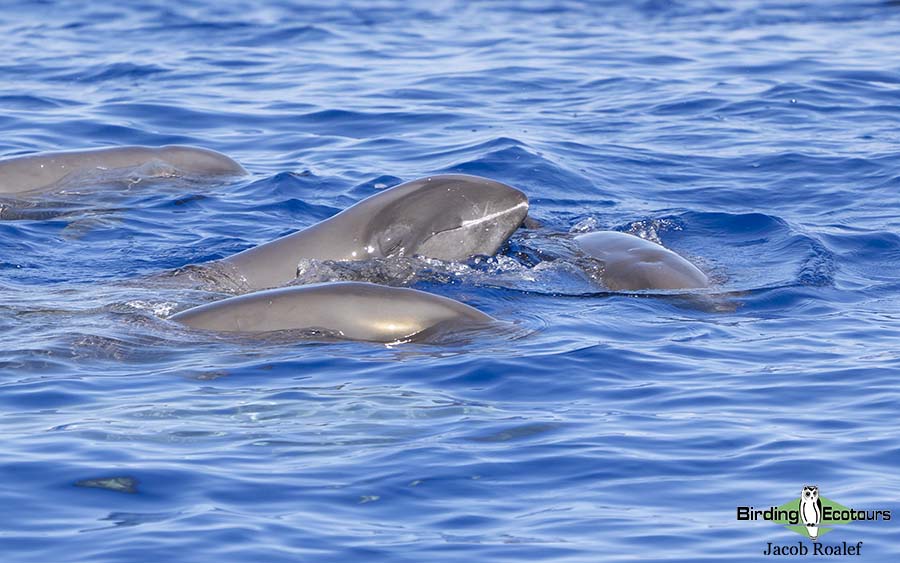
Day 10, 8th February 2023. Departure day
Today we all enjoyed breakfast together, before saying our goodbyes and heading to the airport. This had certainly been a fantastic trip around the Hawaiian Islands. The previous night, I took count of everyone’s top five favorite species of the trip and the results (in no particular order) were: I‘iwi, ‘Akiapola‘au, Laysan Albatross, Bristle-thighed Curlew, and ‘Apapane.
Bird List – Following IOC (12.1)
Birds ‘heard only’ are marked with (H) after the common name, all other species were seen. Species seen only on the pre-trip day of this trip are marked with (+) after the common name.
The following notation after species names is used to show conservation status following BirdLife International: CE = Critically Endangered, EN = Endangered, VU = Vulnerable, NT = Near Threatened.
| Common Name | Scientific Name |
| Ducks, Geese, Swans (Anatidae) | |
| Nene (Endemic) – VU (Hawaiian Goose) | Branta sandvicensis |
| Cackling Goose | Branta hutchinsii |
| Snow Goose | Anser caerulescens |
| Eurasian Wigeon | Mareca penelope |
| American Wigeon | Mareca americana |
| Hawaiian Duck (Endemic) – EN | Anas wyvilliana |
| Northern Pintail | Anas acuta |
| Ring-necked Duck | Aythya collaris |
| Lesser Scaup | Aythya affinis |
| Pheasants & Allies (Phasianidae) | |
| Wild Turkey (Introduced) | Meleagris gallopavo |
| Common Pheasant (Introduced) | Phasianus colchicus |
| Kalij Pheasant (Introduced) | Lophura leucomelanos |
| Red Junglefowl (Introduced) | Gallus gallus |
| Grey Francolin (Introduced) | Ortygornis pondicerianus |
| Black Francolin (Introduced) | Francolinus francolinus |
| Chukar Partridge (Introduced) | Alectoris chukar |
| Erckel’s Spurfowl (Introduced) | Pternistis erckelii |
| Sandgrouse (Pteroclidae) | |
| Chestnut-bellied Sandgrouse (Introduced) | Pterocles exustus |
| Pigeons, Doves (Columbidae) | |
| Rock Dove (Introduced) | Columba livia |
| Spotted Dove (Introduced) | Spilopelia chinensis |
| Zebra Dove (Introduced) | Geopelia striata |
| Rails, Crakes & Coots (Rallidae) | |
| Common Gallinule | Gallinula galeata |
| Hawaiian Coot (Endemic) – VU | Fulica alai |
| Stilts and Avocets (Recurvirostridae) | |
| Black-necked Stilt (Hawaiian) | Himantopus mexicanus |
| Plovers (Charadriidae) | |
| Pacific Golden Plover | Pluvialis fulva |
| Sandpipers, Snipes (Scolopacidae) | |
| Bristle-thighed Curlew | Numenius tahitiensis |
| Ruddy Turnstone | Arenaria interpres |
| Sanderling | Calidris alba |
| Ruff (Rarity) | Calidris pugnax |
| Wandering Tattler | Tringa incana |
| Grey-tailed Tattler (Rarity) | Tringa brevipes |
| Gulls, Terns, Skimmers (Laridae) | |
| Brown Noddy | Anous stolidus |
| Black Noddy | Anous minutus |
| White Tern | Gygis alba |
| Sooty Tern | Onychoprion fuscatus |
| Caspian Tern (Rarity) | Hydroprogne caspia |
| Tropicbirds (Phaethontidae) | |
| Red-tailed Tropicbird | Phaethon rubricauda |
| White-tailed Tropicbird | Phaethon lepturus |
| Albatrosses (Diomedeidae) | |
| Laysan Albatross | Phoebastria immutabilis |
| Northern Storm Petrels (Hydrobatidae) | |
| Leach’s Storm Petrel – VU | Hydrobates leucorhous |
| Band-rumped Storm Petrel | Hydrobates castro |
| Petrels, Shearwaters, Diving Petrels (Procellariidae) | |
| Black-winged Petrel | Pterodroma nigripennis |
| Wedge-tailed Shearwater | Ardenna pacifica |
| Frigatebirds (Fregatidae) | |
| Great Frigatebird | Fregata minor |
| Gannets, Boobies (Sulidae) | |
| Masked Booby | Sula dactylatra |
| Red-footed Booby | Sula sula |
| Brown Booby | Sula leucogaster |
| Herons, Bitterns (Ardeidae) | |
| Black-crowned Night Heron | Nycticorax nycticorax |
| Western Cattle Egret (Introduced) | Bubulcus ibis |
| Ibis and Spoonbills (Threskiornithidae) | |
| White-faced Ibis | Plegadis chihi |
| Kites, Hawks, Eagles (Accipitridae) | |
| Hawaiian Hawk (Endemic) – ‘Io | Buteo solitarius |
| Owls (Strigidae) | |
| Short-eared Owl | Asio flammeus |
| African & New World Parrots (Psittacidae) | |
| Red-masked Parakeet (Introduced) | Psittacara erythrogenyus |
| Old World Parrots (Psittaculidae) | |
| Rose-ringed Parakeet (Introduced) | Psittacula krameri |
| Rosy-faced Lovebird (Introduced) | Agapornis roseicollis |
| Monarchs (Monarchidae) | |
| Kaua‘i ‘Elepaio (Endemic) – VU | Chasiempis sclateri |
| O‘ahu ‘Elepaio (Endemic) – EN | Chasiempis ibidis |
| Hawai‘i Elepaio (Endemic) – VU | Chasiempis sandwichensis |
| Larks (Alaudidae) | |
| Eurasian Skylark (Introduced) | Alauda arvensis |
| Bulbuls (Pycnonotidae) | |
| Red-whiskered Bulbul (Introduced) | Pycnonotus jocosus |
| Red-vented Bulbul (Introduced) | Pycnonotus cafer |
| Cettia Bush Warblers & Allies (Cettiidae) | |
| Japanese Bush Warbler (Introduced) | Horornis diphone |
| White-eyes (Zosteropidae) | |
| Warbling White-eye (Introduced) | Zosterops japonicus |
| Laughingthrushes & Allies (Leiothrichidae) | |
| Red-billed Leiothrix (Introduced) | Leiothrix lutea |
| Mockingbirds, Thrashers (Mimidae) | |
| Northern Mockingbird (Introduced) | Mimus polyglottos |
| Starlings, Rhabdornis (Sturnidae) | |
| Common Myna (Introduced) | Acridotheres tristis |
| Thrushes (Turdidae) | |
| ‘Oma‘o (Endemic) – VU | Myadestes obscurus |
| Chats, Old World Flycatchers (Muscicapidae) | |
| White-rumped Shama (Introduced) | Copsychus malabaricus |
| Old World Sparrows, Snowfinches (Passeridae) | |
| House Sparrow (Introduced) | Passer domesticus |
| Waxbills, Munias & Allies (Estrildidae) | |
| African Silverbill (Introduced) | Euodice cantans |
| Java Sparrow (Introduced) – EN | Padda oryzivora |
| Scaly-breasted Munia (Introduced) | Lonchura punctulata |
| Chestnut Munia (Introduced) | Lonchura atricapilla |
| Common Waxbill (Introduced) | Estrilda astrild |
| Red Avadavat (Introduced) | Amandava amandava |
| Finches, Euphonias (Fringillidae) | |
| I‘iwi (Endemic) – VU | Drepanis coccinea |
| ‘Apapane (Endemic) | Himatione sanguinea |
| ‘Akiapola‘au (Endemic) – EN | Hemignathus wilsoni |
| ‘Anianiau (Endemic) – VU | Magumma parva |
| Hawai‘i Creeper (Endemic) – EN | Loxops mana |
| Hawai‘i ‘Akepa (Endemic) – EN | Loxops coccineus |
| Hawai‘i ‘Amakihi (Endemic) | Chlorodrepanis virens |
| O‘ahu ‘Amakihi (Endemic) – VU | Chlorodrepanis flava |
| Kaua‘i ‘Amakihi (Endemic) – VU | Chlorodrepanis stejnegeri |
| House Finch (Introduced) | Haemorhous mexicanus |
| Yellow-fronted Canary (Introduced) | Crithagra mozambica |
| Oropendolas, Orioles, Blackbirds (Icteridae) | |
| Western Meadowlark (Introduced) | Sturnella neglecta |
| Cardinals & Allies (Cardinalidae) | |
| Northern Cardinal (Introduced) | Cardinalis cardinalis |
| Tanagers & Allies (Thraupidae) | |
| Saffron Finch (Introduced) | Sicalis flaveola |
| Red-crested Cardinal (Introduced) | Paroaria coronata |
| Yellow-billed Cardinal (Introduced) | Paroaria capitata |
| Total Seen | 91 |
Mammal List
| Common Name | Scientific Name |
| Mongooses (Herpestidae) | |
| Indian Grey Mongoose | Urva edwardsii |
| Earless Seals (Phocidae) | |
| Hawaiian Monk Seal – EN | Neomonachus schauinslandi |
| Rorquals (Balaenopteridae) | |
| Humpback Whale | Megaptera novaeangliae |
| Sperm Whale (Physeteridae) | |
| Sperm Whale – VU | Physeter macrocephalus |
| Oceanic Dolphins (Delphinidae) | |
| Spinner Dolphin | Stenella longirostris |
| Melon-headed Whale | Peponocephala electra |
| Cloven-hoofed Mammals (Bovidae) | |
| Mouflon Sheep | Ovis gmelini |
| Total seen | 7 |
DOWNLOAD TRIP REPORT
Please see the downloadable PDF above with the full species lists included. This is a sample trip report. Please email us ([email protected]) for more trip reports from this destination.
USA: Hawaii – ABA and Endemic Birding in the Pacific
Tour-specific Information
PASSPORT AND VISA
For US citizens, no visas or passports are required. You will need to bring along a government issued ID as they are sometimes required for hotels.
Non-United States citizens will require a valid passport to enter the country, and some may require a tourist visa. Please consult with your local US Embassy for more details and information. You may need to show your ID/passport at various hotels and for the boat departures on this tour.
TRAVEL INSURANCE
We strongly encourage you to purchase trip cancellation or interruption insurance in case you have to cancel due to illness or for any other reason, as tour payments are non-refundable as per our terms and conditions. We advise you to get a plan which covers all your medical care and evacuation back to your country of residence, repatriation, and trip cancellation due to illness just prior, or for any other reason.
HEALTH
Hawaii does not pose any major health risks. Its warm and humid climate as well as sometimes muddy terrain are the largest issues. Water will be available throughout the tour and please feel free to bring your own reusable bottle to refill throughout the tour. A good pair of hiking shoes/boots will help with the trails. We also recommend bringing along a walking stick/hiking poles if needed.
MEDICAL CONDITIONS
Please make sure that you are covered by medical insurance in case of an emergency while on this trip. Without insurance the cost of medical care can be extremely high. Please notify us at the time of registering for this tour of any medical conditions you think we should know about (including allergies, heart conditions, epilepsy, etc.). This will greatly help us to cater to your needs and update emergency services if required.
WEATHER/CLIMATE
Daytime temperatures are generally warm 70–80 °F (21–27 °C), however temps will cool off considerably as we climb to higher altitudes on some days. Layers and jackets are a must to help with the wide range of conditions and wind. It is likely to rain at least once while on tour and we will be boarding a pelagic with cool wind blowing off the water. Waterproof and rain gear are essential to ensure comfort while on the tour.
ACCOMMODATIONS
We will be staying at comfortable hotels and resorts, as is the way on Hawaii.
COMMUNICATIONS
Our hotels should have decent access to Wi-Fi throughout the trip and phone service is typically reasonable near these areas and in the larger more populated cities. There are times throughout the trip where we will be out in the wilderness (on certain islands) so do expect to lose coverage in some places.
PHYSICAL REQUIREMENTS AND PACE OF TOUR
Our tour of Hawaii covers three islands in only ten days however, the pace is more comfortable and relaxed overall with plenty of time to search for all target species. There are two flights involved as we island hop, so we will be dealing with airports which are typically a non-issue. Early morning starts are consistent with other birding tours, typically around 6 am. There are no evening/night birding events scheduled on this tour.
Most of the walking is along either roadsides or well-kept trails, completed at a relaxed pace. Terrain on a few trails can be rocky and muddy depending on the weather conditions so walking sticks/hiking poles are recommended, if needed. The majority of the hiking/walking is two miles/three kilometers or less but does involve some altitude and steeper climbs on certain days as we bird in the mountainous regions searching for endemic species. There will always be options to sit out certain hikes or mornings depending on how you might be feeling and your own personal capabilities.
WHAT TO BRING
Please kindly read the general list of what to bring on a birding tour, here.
Layers and rain gear are always a good idea when preparing for a wide variety of weather conditions, and we consider them essential on this tour. We also do recommend bringing Dramamine or other motion sickness medications, if you need them, as there are a few longer drives in the vehicle and a pelagic trip. Also, please bring along a face mask (or a few) to ensure we are able to follow local guidelines during the Covid-19 pandemic as they will be required in certain areas.
Do not forget – Binoculars, prescription drugs (also bring the generic names for these drugs), toiletries, prescription glasses (and a spare pair), sunglasses, camera, batteries (for electronic equipment and chargers for re-chargeable batteries, if required), alarm clock, money pouch, field guide(s), daypack.
Key documents and cash – Passports, your travel or health insurance cards, photocopies of which can be carried by the tour leader in case of emergency, Covid-19 vaccine card, photos/screenshots of vaccine card, credit cards (see info above). US dollars for drinks, gifts, tips, items of a personal nature, etc., which are not included in the tour cost.
LUGGAGE
There should be enough space for each participant to bring one medium-sized suitcase as well as a personal bag to keep at their seat with them. Please do be mindful with large cameras or tripods if you choose to bring these along.
Download Hawaii: ABA and Endemic Birding in the Pacific Information
‘I would highly recommend this tour for anyone interested in seeing the beautiful endemic birds of Hawaii before they are gone, and enjoying the natural beauty of the islands. Mandy Talpas, the local guide, did an excellent job sharing her vast knowledge of the endemic birds, their habitat, and the diseases that are threatening them. Jacob Roalef, who also shared his vast knowledge of the birds, and Mandy were very attentive to everyone’s needs, which included 8 participants with varying degrees of birding experience. The beauty of the islands and endemic birds, as well as the camaraderie of the participants and guides made this tour one of the best for me! The accommodations and foodwere great too!’
Karen
‘I would highly recommend this tour to anyone that is interested in seeing Hawaii’s native birds on these beautiful islands. One of my favorites was the endangered Akiapolaau, referred to as Aki by our guides, which we saw in a restricted area by permit on the island of Hawaii. The Hawaiian name means “hammerhead,” because the Aki uses the shorter, lower half of it’s mandible to drill into tree trunks like a woodpecker for sap or insects, while the extended, curved upper half operates like a hook to extract the food. During our day spent exploring the restricted area for Hawaii’s endemic birds, three non-endemic (two males and one female) Kalij Pheasants walked across the path right in front of me. I also loved the fantastic coastal views where we observed Red-tailed, White-tailed, and Red-billed Tropicbirds, Red-Footed and Brown Boobies, and Great Frigatebirds, as well as spouting and breaching Humpback whales. I also enjoyed the opportunity to see Laysan Albatross nesting and walking around an upscale neighborhood, and Bristle-thighed Curlews perched in the cemetery from the golf course.’
Diane
‘The Hawaiian birding tour is a birding tour with a difference! With only a small bird list mostly, comprising of highly endangered endemic birds or many introduced birds from all over the world. The pace of the tour is a very relaxed one and perfect for those who want to experience top quality birds, top quality accommodation, an exuberant, passionate, knowledgeable guide who takes good care of you and delicious sea food with a wonderful one day pelagic with an opportunity of seeing Manta Rays up close and personal in the sea.’
Sue
‘All days were good but Day 8 in Hakalau Forest and Day 9 on the ocean were exceptional both providing sights to be long remembered. All of the endemic honeycreepers were well observed in nice weather in Hakalau Forest. The pelagic outing will stand out for the cetaceans – two sperm whales, a mother and calf Humpback and numerous Mellon-headed Whales!’
John
‘Jacob and Mandy were an excellent team who guided us through the mountains, forests and shores, as well and urban areas of Oahu, Kauai and Hawaii. Both guides knew their birds well. Mandy, our local guide, was very swift to identify calls and knows the habitats of many endangered endemic birds. She also knows individual birds and their histories. Both guides made sure we all saw the birds we were looking for each trip. The scopes came out quickly and there was often enough time to snap a cell phone photo through the scope. Jacob has an amazing grasp of names and places and did an excellent job of compiling our E bird lists. They tour guides informed us each night before of the coming schedule which was very helpful. They worked seamlessly together and we benefited from their camaraderie. Hotel, food, transportation, side trips – all were excellent. This was a once-in-a-lifetime trip for me. I am grateful to all involved for providing such an exceptional tour.’
Janice
